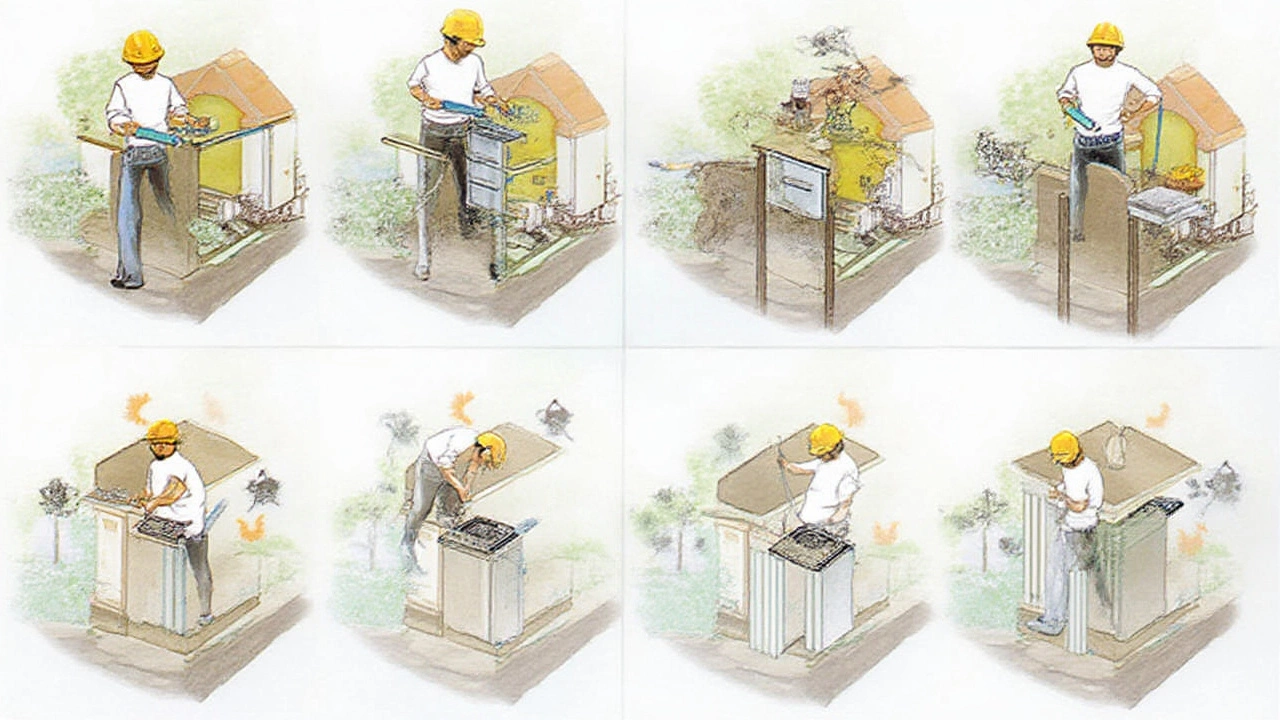Picture this: You spot a crack snaking up your living room wall, and suddenly you’re calculating just how much it’ll cost to fix, how big the problem really is, and most importantly—if foundation repair even works for the long haul. Can a builder’s injection or some new piers under your house truly solve sinking floors or sticky doors, or is this just patching a patient who’ll always need check-ups?
There’s no room for guesswork when you’re talking about the bones of your home—both for your wallet and your safety. Let’s pull the lid off the mysteries of foundation repair and see what’s myth, what really works, and if those big fixes last long enough to count as peace of mind.
How Foundation Problems Start, and How Repairs Actually Work
Most homes, even new ones, face foundation issues at some point. The most common triggers? Soil shifts, moisture changes, poor drainage, earthquakes, or—sometimes—the builder just plain cut corners. You’re likely to see things like stair-step cracks in the brickwork, gaps at the window frames, or even doors that won't budge come summer.
Most folks imagine foundation repair as some Herculean task, maybe something out of a disaster movie. In real life, it’s usually way more technical and precise—which is good news for homeowners (and a relief for your bank account). Let’s break down the main repair techniques you’ll hear about when you call a pro:
- Piering or underpinning: Technicians drive steel or concrete piers deep into stable soil beneath your foundation, then lift the house back into place and secure it. This is a favorite solution for homes built on highly expansive soils or in areas with a lot of shifting.
- Slabjacking (mudjacking): This one’s kind of fun—crews inject a concrete slurry under a sunken slab. The mixture fills voids and lifts the slab upward. It’s a go-to move for sidewalks, driveways, garages, and sometimes interior floors if access is right.
- Epoxy injections: For non-moving cracks, professionals use strong epoxies to fill and bond cracks in poured concrete, sealing them up and shoring things up for the future. But if your house is still shifting, this technique is pretty much just a band-aid.
- Drainage and grading fixes: Often, controlling water is half the battle. Pros might install French drains, improve gutters, or regrade the yard to steer rain away from your foundation. Sometimes, these fixes alone prevent the need for more invasive repairs.
Choosing one method over another comes down to soil type, severity of the problem, house design, and even your future plans. If you want to sell in five years, your choices might be different than if you see yourself staring at those walls for decades.
Now, here’s a quick reality check: No foundation repair method magically makes a house “like new.” But the good ones restore stability, prevent further movement, and help your home meet current safety and resale standards.

Foundation Repair: Myths, Real-Life Results, and What the Data Shows
Let’s bust a myth: foundation repairs aren’t just an expensive gamble or a temporary fix—if done right. A study shared by the Foundation Repair Association in 2023 looked at 1,200 homes with various repairs using piers and slabjacking over 10 years. The failure/repeat-fix rate clocked in at just 7.3%, and almost all those cases were due to extreme flooding or new drainage problems—nothing to do with the original job. That’s a stat you can work with.
That’s not all. According to a recent homeowner survey in Texas (where expansive clay soils make foundation issues legendary), 89% of homeowners reported that professionally-completed piering solved their door-sticking problems for at least 8 years, with visible cracks closing up and staying closed. But here’s the kicker: among those who skipped fixing drainage, more than half still saw small new cracks or minor settling within 3 years. It’s not just about brute force repairs—it’s about fixing the causes.
| Repair Method | Average Lifespan | Typical Cost (2025 USD) | Success Rate After 5 Years |
|---|---|---|---|
| Piering (Steel Piers) | 20-75 years | $10,000 - $40,000 | 92% |
| Slabjacking | 8-15 years | $2,500 - $8,000 | 75% |
| Epoxy Injection | 10-20 years (for cracks only) | $500 - $2,000 | 65% |
| Drainage Corrections | 15-40 years | $1,000 - $6,000 | 90% |
Let me hit that home: the biggest predictor for success isn’t the technology, but the skill of the crew and follow-up care. Some bad apples take shortcuts, do poor prep, or use cheap materials. That’s when you get the horror stories. A solid warranty from a known company isn’t just a sales line—it’s an insurance policy for your house’s future.
And the notion that repairs “wreck resale value”? Not true if you handle them right. It’s rare to see resale penalties for completed, warrantied repairs—especially if you show before/after pics and paperwork. The opposite’s true: buyers walk away faster from a cracked foundation than from a house with a professional fix record.
If you want the story straight from homeowners, scroll through any online forum or review site. You’ll see straight talk—folks complaining about contractors who vanished or repairs that failed because of new, untreated leaks, but way more people relieved that their floors leveled out, brick stopped cracking, doors shut, and life could go back to normal.
One more thing—a lot of “foundation repair” ads try to sell you extra stuff you don’t need: wall anchors in solid soil, unnecessary sump pumps, expensive foam injections when drainage is the problem. Before signing anything, get at least two opinions and ask for an explanation that makes sense to you, not just the technician.

Tips, Warnings, and Realistic Expectations for Homeowners Facing Repairs
So, does foundation repair really work? The simple answer: yes, but only if you choose proven solutions, fix the root cause, and don’t skip the basics. Want your money and effort to pay off for good? Keep these tips in your back pocket:
- Insist on soil testing. If your house is moving, you need to know why. Stable clay behaves very differently than loose fill. Get a soil analysis—it might cost $500 but it could save you $10,000 in pointless repairs.
- Address water issues first. If the “why” behind your foundation problems is pooling water or bad grading, fix that first, or you’ll just end up back where you started (but with a lighter wallet).
- Document everything. Good contractors provide warranty details, before-and-after monitoring data, and clear explanations. If they can’t show proof of permits or insurance, walk away.
- Prepare for disruption. Real repairs are not quiet. Expect drilling, excavaters, maybe some dust or even power-off days. The bigger the repair, the more you’ll need to move furniture, skip parking in the garage, or even bunk with family for a couple nights.
- Understand the timeline. Most big repairs take between three days and two weeks. You may need to wait for soil to dry after heavy rain, too. Rushing the crew is seldom worth it.
- Set realistic expectations. Even high-end repairs can’t always erase hairline cracks or level all floors to laser precision—especially in older homes where “character” is code for “lumpy.” But they will stop further damage and stabilize everything so you can build or remodel with confidence.
- Keep up with maintenance. After the fix, regular checkups matter. Watch for new leaks, overflowing gutters, or odd landscaping changes. Early repairs catch problems before they snowball.
There’s peace of mind in knowing modern methods aren't just hype. The foundation repair industry is more transparent than ever, with certifications, case tracking, and Google reviews catching scammers. Still, you need to be alert: don’t accept vague answers, and definitely never sign anything under pressure.
If you’re wondering if foundation repair really works, the answer is right below your feet—sometimes literally. When you invest in the right repairs, and do it for the right reasons—not just appearances—you’re not just patching up, you’re buying back years of stability and safety for your place. That’s worth real money, and a little sleep at night, too.

Written by Fletcher Abernathy
View all posts by: Fletcher Abernathy